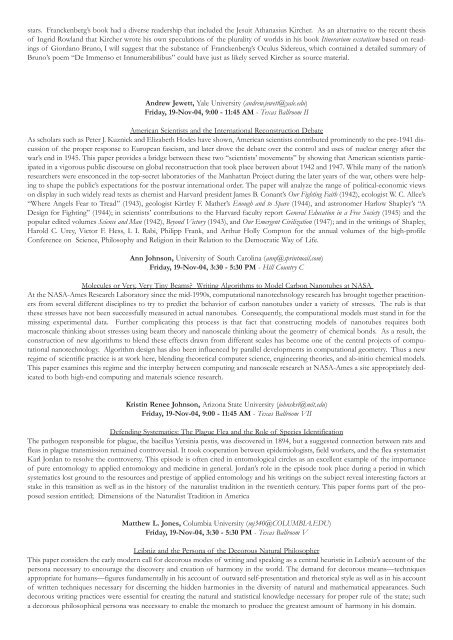Abstracts of the History of Science Society 2004 Austin Meeting 18 ...
Abstracts of the History of Science Society 2004 Austin Meeting 18 ...
Abstracts of the History of Science Society 2004 Austin Meeting 18 ...
Create successful ePaper yourself
Turn your PDF publications into a flip-book with our unique Google optimized e-Paper software.
stars. Franckenberg’s book had a diverse readership that included <strong>the</strong> Jesuit Athanasius Kircher. As an alternative to <strong>the</strong> recent <strong>the</strong>sis<br />
<strong>of</strong> Ingrid Rowland that Kircher wrote his own speculations <strong>of</strong> <strong>the</strong> plurality <strong>of</strong> worlds in his book Itinerarium exstaticum based on readings<br />
<strong>of</strong> Giordano Bruno, I will suggest that <strong>the</strong> substance <strong>of</strong> Franckenberg’s Oculus Sidereus, which contained a detailed summary <strong>of</strong><br />
Bruno’s poem “De Immenso et Innumerabilibus” could have just as likely served Kircher as source material.<br />
Andrew Jewett, Yale University (andrew.jewett@yale.edu)<br />
Friday, 19-Nov-04, 9:00 - 11:45 AM - Texas Ballroom II<br />
American Scientists and <strong>the</strong> International Reconstruction Debate<br />
As scholars such as Peter J. Kuznick and Elizabeth Hodes have shown, American scientists contributed prominently to <strong>the</strong> pre-1941 discussion<br />
<strong>of</strong> <strong>the</strong> proper response to European fascism, and later drove <strong>the</strong> debate over <strong>the</strong> control and uses <strong>of</strong> nuclear energy after <strong>the</strong><br />
war’s end in 1945. This paper provides a bridge between <strong>the</strong>se two “scientists’ movements” by showing that American scientists participated<br />
in a vigorous public discourse on global reconstruction that took place between about 1942 and 1947. While many <strong>of</strong> <strong>the</strong> nation’s<br />
researchers were ensconced in <strong>the</strong> top-secret laboratories <strong>of</strong> <strong>the</strong> Manhattan Project during <strong>the</strong> later years <strong>of</strong> <strong>the</strong> war, o<strong>the</strong>rs were helping<br />
to shape <strong>the</strong> public’s expectations for <strong>the</strong> postwar international order. The paper will analyze <strong>the</strong> range <strong>of</strong> political-economic views<br />
on display in such widely read texts as chemist and Harvard president James B. Conant’s Our Fighting Faith (1942), ecologist W. C. Allee’s<br />
“Where Angels Fear to Tread” (1943), geologist Kirtley F. Ma<strong>the</strong>r’s Enough and to Spare (1944), and astronomer Harlow Shapley’s “A<br />
Design for Fighting” (1944); in scientists’ contributions to <strong>the</strong> Harvard faculty report General Education in a Free <strong>Society</strong> (1945) and <strong>the</strong><br />
popular edited volumes <strong>Science</strong> and Man (1942), Beyond Victory (1943), and Our Emergent Civilization (1947); and in <strong>the</strong> writings <strong>of</strong> Shapley,<br />
Harold C. Urey, Victor F. Hess, I. I. Rabi, Philipp Frank, and Arthur Holly Compton for <strong>the</strong> annual volumes <strong>of</strong> <strong>the</strong> high-pr<strong>of</strong>ile<br />
Conference on <strong>Science</strong>, Philosophy and Religion in <strong>the</strong>ir Relation to <strong>the</strong> Democratic Way <strong>of</strong> Life.<br />
Ann Johnson, University <strong>of</strong> South Carolina (annj@sprintmail.com)<br />
Friday, 19-Nov-04, 3:30 - 5:30 PM - Hill Country C<br />
Molecules or Very, Very Tiny Beams? Writing Algorithms to Model Carbon Nanotubes at NASA<br />
At <strong>the</strong> NASA-Ames Research Laboratory since <strong>the</strong> mid-1990s, computational nanotechnology research has brought toge<strong>the</strong>r practitioners<br />
from several different disciplines to try to predict <strong>the</strong> behavior <strong>of</strong> carbon nanotubes under a variety <strong>of</strong> stresses. The rub is that<br />
<strong>the</strong>se stresses have not been successfully measured in actual nanotubes. Consequently, <strong>the</strong> computational models must stand in for <strong>the</strong><br />
missing experimental data. Fur<strong>the</strong>r complicating this process is that fact that constructing models <strong>of</strong> nanotubes requires both<br />
macroscale thinking about stresses using beam <strong>the</strong>ory and nanoscale thinking about <strong>the</strong> geometry <strong>of</strong> chemical bonds. As a result, <strong>the</strong><br />
construction <strong>of</strong> new algorithms to blend <strong>the</strong>se effects drawn from different scales has become one <strong>of</strong> <strong>the</strong> central projects <strong>of</strong> computational<br />
nanotechnology. Algorithm design has also been influenced by parallel developments in computational geometry. Thus a new<br />
regime <strong>of</strong> scientific practice is at work here, blending <strong>the</strong>oretical computer science, engineering <strong>the</strong>ories, and ab-initio chemical models.<br />
This paper examines this regime and <strong>the</strong> interplay between computing and nanoscale research at NASA-Ames a site appropriately dedicated<br />
to both high-end computing and materials science research.<br />
Kristin Renee Johnson, Arizona State University (johnskri@mit.edu)<br />
Friday, 19-Nov-04, 9:00 - 11:45 AM - Texas Ballroom VII<br />
Defending Systematics: The Plague Flea and <strong>the</strong> Role <strong>of</strong> Species Identification<br />
The pathogen responsible for plague, <strong>the</strong> bacillus Yersinia pestis, was discovered in <strong>18</strong>94, but a suggested connection between rats and<br />
fleas in plague transmission remained controversial. It took cooperation between epidemiologists, field workers, and <strong>the</strong> flea systematist<br />
Karl Jordan to resolve <strong>the</strong> controversy. This episode is <strong>of</strong>ten cited in entomological circles as an excellent example <strong>of</strong> <strong>the</strong> importance<br />
<strong>of</strong> pure entomology to applied entomology and medicine in general. Jordan’s role in <strong>the</strong> episode took place during a period in which<br />
systematics lost ground to <strong>the</strong> resources and prestige <strong>of</strong> applied entomology and his writings on <strong>the</strong> subject reveal interesting factors at<br />
stake in this transition as well as in <strong>the</strong> history <strong>of</strong> <strong>the</strong> naturalist tradition in <strong>the</strong> twentieth century. This paper forms part <strong>of</strong> <strong>the</strong> proposed<br />
session entitled; Dimensions <strong>of</strong> <strong>the</strong> Naturalist Tradition in America<br />
Mat<strong>the</strong>w L. Jones, Columbia University (mj340@COLUMBIA.EDU)<br />
Friday, 19-Nov-04, 3:30 - 5:30 PM - Texas Ballroom V<br />
Leibniz and <strong>the</strong> Persona <strong>of</strong> <strong>the</strong> Decorous Natural Philosopher<br />
This paper considers <strong>the</strong> early modern call for decorous modes <strong>of</strong> writing and speaking as a central heuristic in Leibniz’s account <strong>of</strong> <strong>the</strong><br />
persona necessary to encourage <strong>the</strong> discovery and creation <strong>of</strong> harmony in <strong>the</strong> world. The demand for decorous means—techniques<br />
appropriate for humans—figures fundamentally in his account <strong>of</strong> outward self-presentation and rhetorical style as well as in his account<br />
<strong>of</strong> written techniques necessary for discerning <strong>the</strong> hidden harmonies in <strong>the</strong> diversity <strong>of</strong> natural and ma<strong>the</strong>matical appearances. Such<br />
decorous writing practices were essential for creating <strong>the</strong> natural and statistical knowledge necessary for proper rule <strong>of</strong> <strong>the</strong> state; such<br />
a decorous philosophical persona was necessary to enable <strong>the</strong> monarch to produce <strong>the</strong> greatest amount <strong>of</strong> harmony in his domain.
















